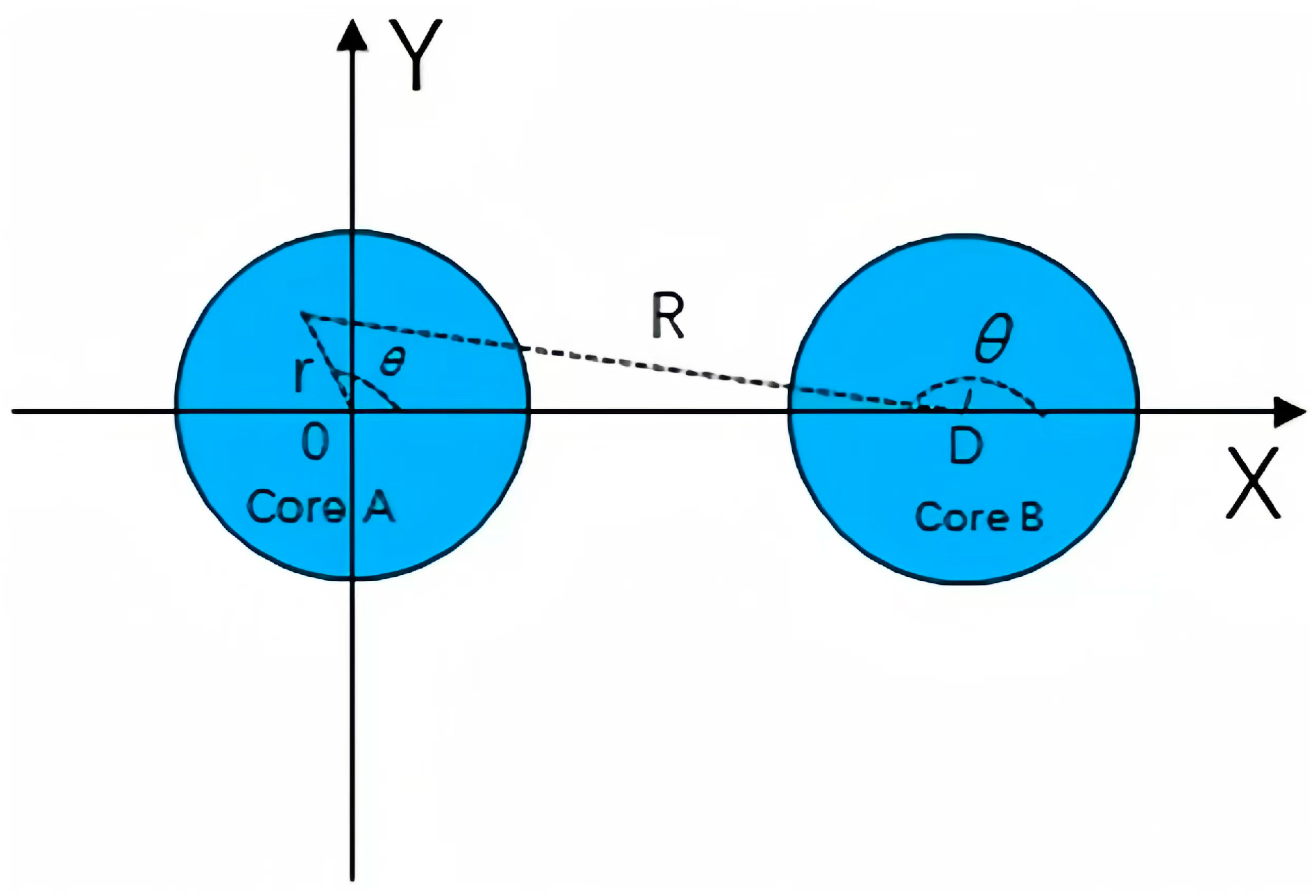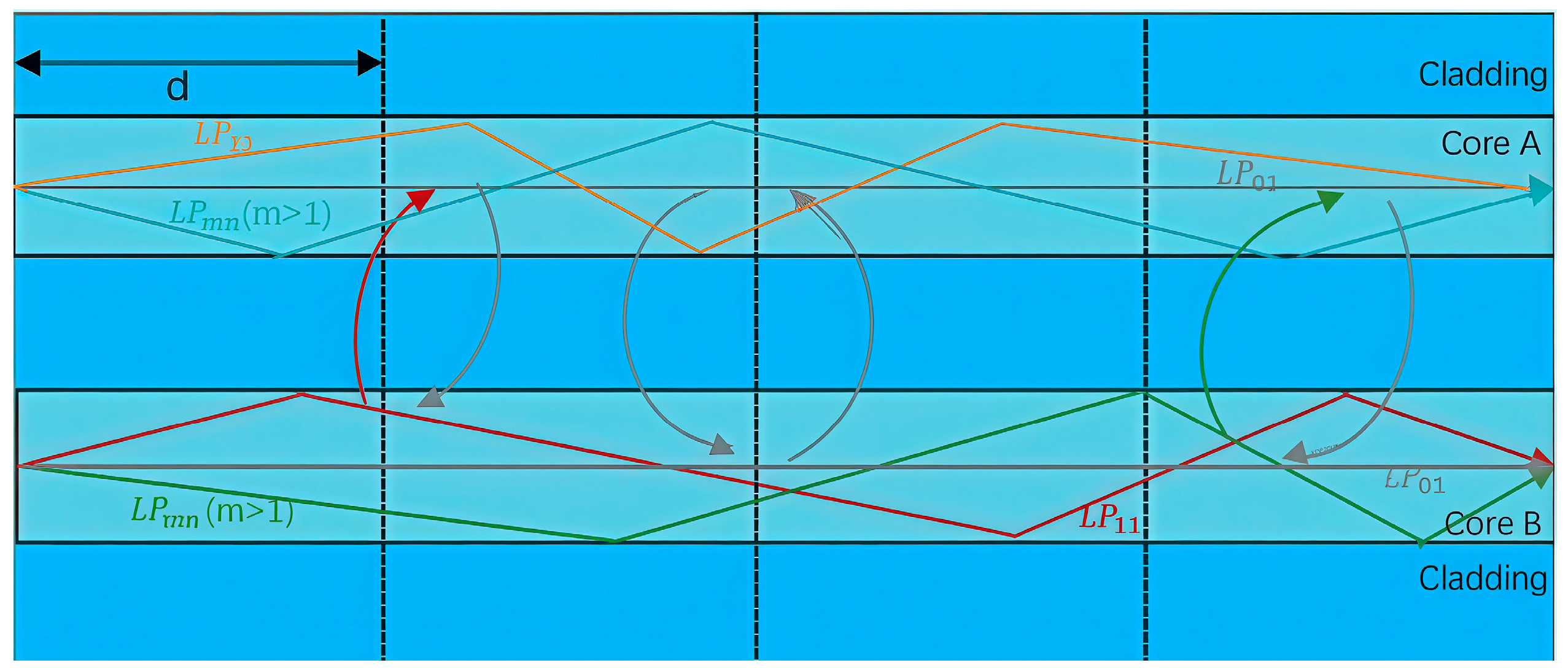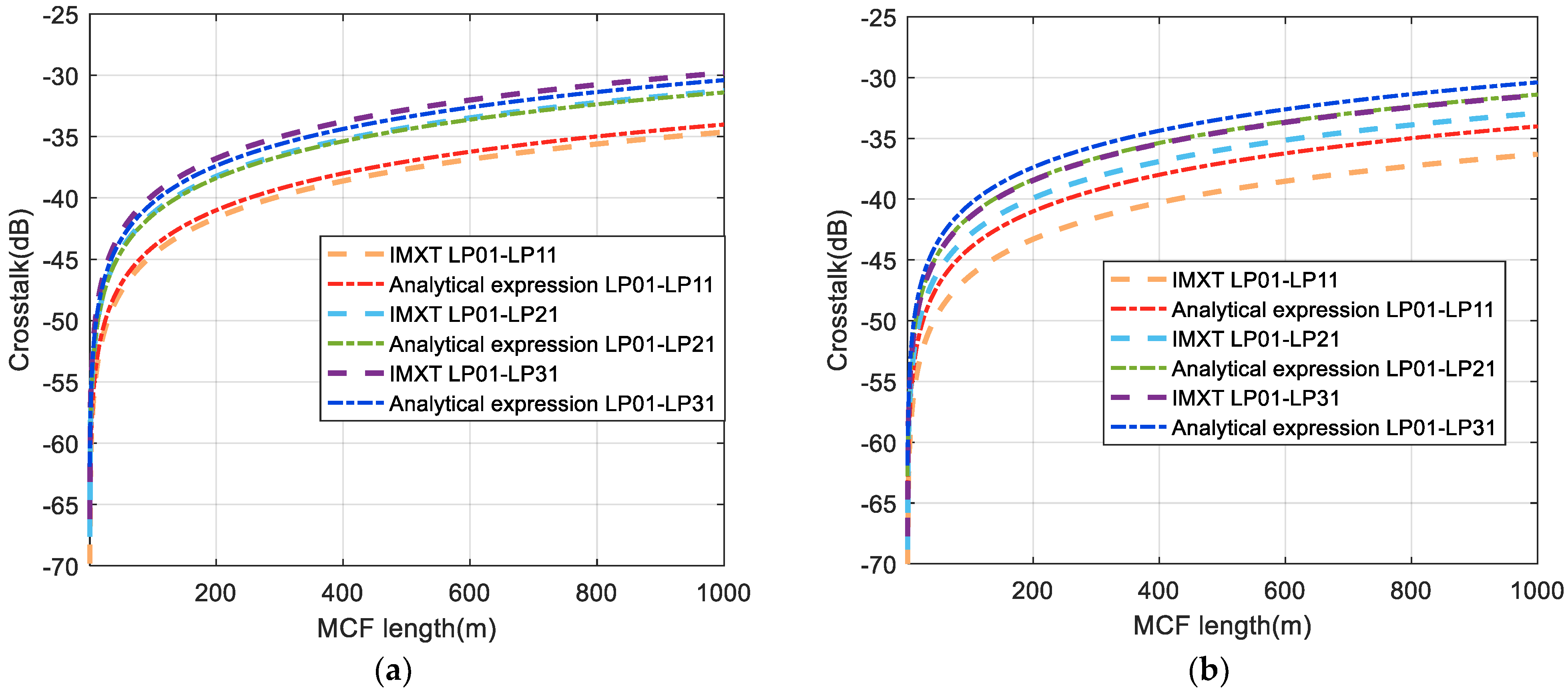Inter-Mode Crosstalk Estimation between Cores for LPmn Modes in Weakly Coupled Few-Mode Multicore Fiber with Perturbations
Abstract
:1. Introduction
2. Analysis and Methods
2.1. Mode Coupling Coefficient of Mode
2.2. Electric Field of Mode Based on Maxwell Equations
2.3. Inter-Mode Crosstalk Based on CMT
3. Results and Discussion
3.1. Fiber Parameter
3.2. IMXT Analysis of Two-Core Few-Mode Fiber
3.3. IMXT Analysis of Four-Core Few-Mode Fiber
4. Conclusions
Author Contributions
Funding
Data Availability Statement
Conflicts of Interest
Appendix A
References
- Saitoh, K.; Matsuo, S. Multicore Fiber Technology. J. Light. Technol. 2016, 34, 55–66. [Google Scholar] [CrossRef]
- Richardson, D.J.; Fini, J.M.; Nelson, L.E. Space-Division Multiplexing in Optical Fibres. Nat. Photonics 2013, 7, 354–362. [Google Scholar] [CrossRef]
- Dablu, K.; Rakesh, R. Appropriate Method of Core Selection and Crosstalk Optimization in Single-Mode Homogeneous Multicore Fiber. Opt. Electron. Lett. 2020, 16, 126–130. [Google Scholar] [CrossRef]
- Rademacher, G.; Luis, R.S.; Puttnam, B.J.; Ryf, R.; van Eriksson, T.A.; Fontaine, N.K.; Chen, H.; Essiambre, R.-J.; Awaji, Y.; Wada, N. High Capacity Transmission in a Coupled-Core Three-Core Multi-Core Fiber. J. Light. Technol. 2021, 39, 757–762. [Google Scholar] [CrossRef]
- Sillard, P.; Molin, D.; Bigot-Astruc, M.; Amezcua-Correa, A.; de Jongh, K.; Achten, F. 50 Μm Multimode Fibers for Mode Division Multiplexing. J. Light. Technol. 2016, 34, 1672–1677. [Google Scholar] [CrossRef]
- Takenaga, K.; Sasaki, Y.; Guan, N.; Matsuo, S.; Kasahara, M.; Saitoh, K.; Koshiba, M. Large Effective-Area Few-Mode Multicore Fiber. IEEE. Photonics Technol. Lett. 2012, 24, 1941–1944. [Google Scholar] [CrossRef]
- van Uden, R.G.H.; Correa, R.A.; Lopez, E.; Huijskens, F.; Xia, C.; Li, G.; Schülzgen, A.; de Waardt, H.; Koonen, A.M.J.; Okonkwo, C. Ultra-High-Density Spatial Division Multiplexing with a Few-Mode Multicore Fibre. Nat. Photonics 2014, 8, 865–870. [Google Scholar] [CrossRef]
- Shao, P.; Wang, L.; Wang, Y.; Li, S.; Li, Z.; Wang, X.; Ma, L.; Meng, X.; Guo, Y.; Li, J.; et al. Preparation and Transmission Characteristics of Seven-Core Few-Mode Fiber with Low Loss and Low Inter-Core Crosstalk. Opt. Express 2022, 30, 27746. [Google Scholar] [CrossRef]
- Fini, J.M.; Zhu, B.; Taunay, T.F.; Yan, M.F. Statistics of Crosstalk in Bent Multicore Fibers. Opt. Express 2010, 18, 15122. [Google Scholar] [CrossRef]
- Puttnam, B.J.; Luís, R.S.; Agrell, E.; Rademacher, G.; Shen, J.; Klaus, W.; Saridis, G.M.; Awaji, Y.; Wada, N. High Capacity Transmission Systems Using Homogeneous Multi-Core Fibers. J. Light. Technol. 2017, 35, 1157–1167. [Google Scholar] [CrossRef]
- Amaya, N.; Yan, S.; Channegowda, M.; Rofoee, B.R.; Shu, Y.; Rashidi, M.; Ou, Y.; Hugues-Salas, E.; Zervas, G.; Nejabati, R.; et al. Software Defined Networking (SDN) over Space Division Multiplexing (SDM) Optical Networks: Features, Benefits and Experimental Demonstration. Opt. Express 2014, 22, 3638. [Google Scholar] [CrossRef] [PubMed]
- Sano, A.; Takara, H.; Kobayashi, T.; Miyamoto, Y. Crosstalk-Managed High Capacity Long Haul Multicore Fiber Transmission with Propagation-Direction Interleaving. J. Light. Technol. 2014, 32, 2771–2779. [Google Scholar] [CrossRef]
- Soeiro, R.O.; Alves, T.M.; Cartaxo, A.V. Impact of Longitudinal Variation of the Coupling Coefficient due to Bending and Twisting on Inter-Core Crosstalk in Weakly-Coupled MCFs. J. Light. Technol. 2018, 36, 3898–3911. [Google Scholar] [CrossRef]
- Soeiro, R.O.J.; Alves, T.M.F.; Cartaxo, A.V.T. Inter-Core Crosstalk in Weakly Coupled MCFs with Arbitrary Core Layout and the Effect of Bending and Twisting on the Coupling Coefficient. Opt. Express 2019, 27, 74. [Google Scholar] [CrossRef] [PubMed]
- Soeiro, R.O.J.; Alves, T.M.F.; Cartaxo, A.V.T. Dual Polarization Discrete Changes Model of Inter-Core Crosstalk in Multi-Core Fibers. IEEE Photonics Technol. Lett. 2017, 29, 1395–1398. [Google Scholar] [CrossRef]
- Hayashi, T.; Taru, T.; Shimakawa, O.; Sasaki, T.; Sasaoka, E. Design and Fabrication of Ultra-Low Crosstalk and Low-Loss Multi-Core Fiber. Opt. Express 2011, 19, 16576. [Google Scholar] [CrossRef]
- Cartaxo, A.V.T.; Alves, T.M.F. Discrete Changes Model of Inter-Core Crosstalk of Real Homogeneous Multi-Core Fibers. J. Light. Technol. 2017, 35, 2398–2408. [Google Scholar] [CrossRef]
- Ye, F.; Tu, J.; Saitoh, K.; Morioka, T. Simple Analytical Expression for Crosstalk Estimation in Homogeneous Trench-Assisted Multi-Core Fibers. Opt. Express 2014, 22, 23007. [Google Scholar] [CrossRef]
- Wang, W.; Xiang, L.; Shao, W.; Shen, G. Stochastic Crosstalk Analyses for Real Weakly Coupled Multicore Fibers Using a Universal Semi-Analytical Model. J. Light. Technol. 2021, 39, 4503–4510. [Google Scholar] [CrossRef]
- Koshiba, M.; Saitoh, K.; Takenaga, K.; Matsuo, S. Multi-Core Fiber Design and Analysis: Coupled-Mode Theory and Coupled-Power Theory. Opt. Express 2011, 19, B102. [Google Scholar] [CrossRef]
- Li, M.-J.; Li, S.; Modavis, R.A. Coupled Mode Analysis of Crosstalk in Multicore Fiber with Random Perturbations. In Proceedings of the Optical Fiber Communication Conference, Los Angeles, CA, USA, 22–26 March 2015. [Google Scholar]
- Zhou, J.; Pu, H. Generalized Analytical Study on the Random Crosstalk in Multicore/Multimode Fibers. J. Light. Technol. 2022, 40, 1112–1120. [Google Scholar] [CrossRef]
- Antonelli, C.; Riccardi, G.; Hayashi, T.; Mecozzi, A. Role of Polarization-Mode Coupling in the Crosstalk between Cores of Weakly-Coupled Multi-Core Fibers. Opt. Express 2020, 28, 12847. [Google Scholar] [CrossRef] [PubMed]
- Zhou, J.; Pu, H. Analytical Expressions for the Crosstalk of Super-Modes in the Tightly Bounded Multicore Fibers. Opt. Express 2022, 30, 4833–4844. [Google Scholar] [CrossRef] [PubMed]
- Hayashi, T.; Sasaki, T.; Sasaoka, E.; Saitoh, K.; Koshiba, M. Physical Interpretation of Intercore Crosstalk in Multicore Fiber: Effects of Macrobend, Structure Fluctuation, and Microbend. Opt. Express 2013, 21, 5401–5412. [Google Scholar] [CrossRef] [PubMed]
- Fini, J.M.; Zhu, B.; Taunay, T.F.; Yan, M.F.; Abedin, K.S. Crosstalk in Multicore Fibers with Randomness: Gradual Drift vs Short-Length Variations. Opt. Express 2012, 20, 949–959. [Google Scholar] [CrossRef]
- Okamoto, K. Fundamentals of Optical Waveguides; Elsevier: Amsterdam, The Netherlands, 2010. [Google Scholar]
- Hayashi, T.; Nagashima, T.; Shimakawa, O.; Sasaki, T.; Sasaoka, E. Crosstalk Variation of Multi-Core Fibre due to Fibre Bend. In Proceedings of the 2010 36th European Conference and Exhibition on Optical Communication—(ECOC 2010), Torino, Italy, 19–23 September 2010. [Google Scholar]
- Fujisawa, T.; Amma, Y.; Sasaki, Y.; Matsuo, S.; Aikawa, K.; Saitoh, K.; Koshiba, M. Crosstalk Analysis of Heterogeneous Multicore Fibers Using Coupled-Mode Theory. IEEE. Photonics Technol. Lett. 2017, 9, 1–8. [Google Scholar] [CrossRef]







| Parameters | Symbol | Value |
|---|---|---|
| Core pitch | ||
| Core radius | ||
| Core index | 1.4530 | |
| Cladding index | 1.444 | |
| Wavelength | ||
| Bending radius | ||
| Twisting rate |
Disclaimer/Publisher’s Note: The statements, opinions and data contained in all publications are solely those of the individual author(s) and contributor(s) and not of MDPI and/or the editor(s). MDPI and/or the editor(s) disclaim responsibility for any injury to people or property resulting from any ideas, methods, instructions or products referred to in the content. |
© 2024 by the authors. Licensee MDPI, Basel, Switzerland. This article is an open access article distributed under the terms and conditions of the Creative Commons Attribution (CC BY) license (https://creativecommons.org/licenses/by/4.0/).
Share and Cite
Liu, S.; Xiang, L. Inter-Mode Crosstalk Estimation between Cores for LPmn Modes in Weakly Coupled Few-Mode Multicore Fiber with Perturbations. Sensors 2024, 24, 5969. https://doi.org/10.3390/s24185969
Liu S, Xiang L. Inter-Mode Crosstalk Estimation between Cores for LPmn Modes in Weakly Coupled Few-Mode Multicore Fiber with Perturbations. Sensors. 2024; 24(18):5969. https://doi.org/10.3390/s24185969
Chicago/Turabian StyleLiu, Shuangmeng, and Lian Xiang. 2024. "Inter-Mode Crosstalk Estimation between Cores for LPmn Modes in Weakly Coupled Few-Mode Multicore Fiber with Perturbations" Sensors 24, no. 18: 5969. https://doi.org/10.3390/s24185969
APA StyleLiu, S., & Xiang, L. (2024). Inter-Mode Crosstalk Estimation between Cores for LPmn Modes in Weakly Coupled Few-Mode Multicore Fiber with Perturbations. Sensors, 24(18), 5969. https://doi.org/10.3390/s24185969




